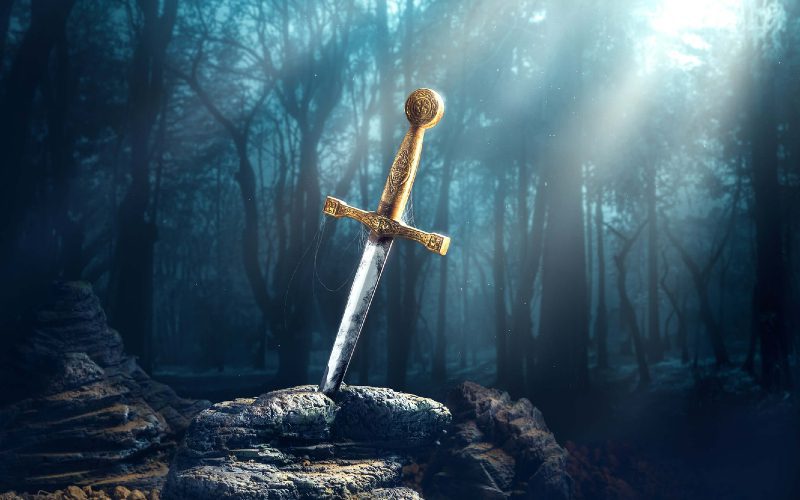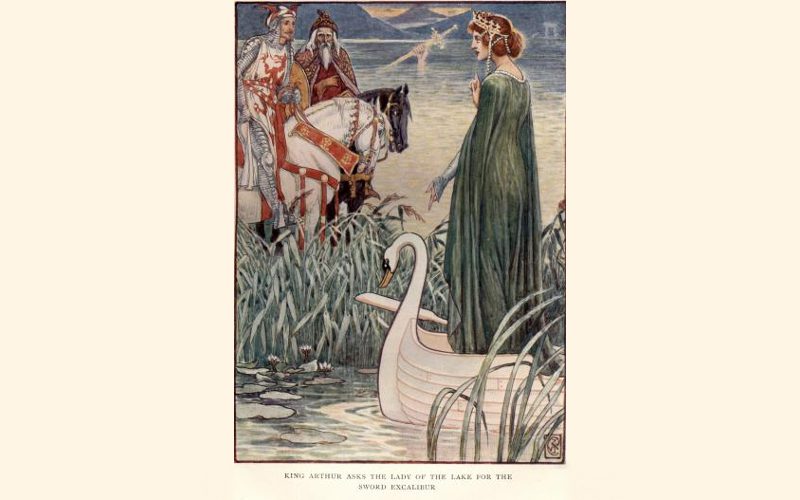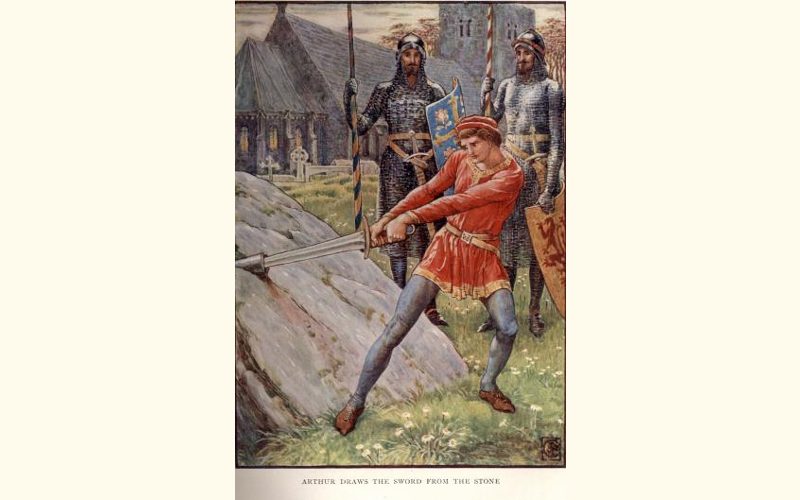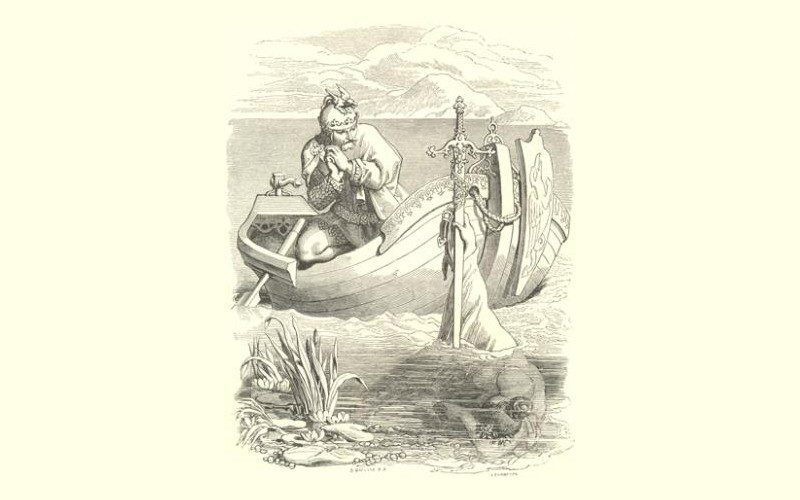King Arthur’s Excalibur Sword: Its Origin and History

What’s in this article?
One of the most famous swords in European legends, the Excalibur belonged to King Arthur of Camelot. In Arthurian legends, the magical
So, let us explore the history of the Excalibur and how much truth there is to the Arthurian legends.
Was King Arthur a real person?
Historians have been unable to confirm that King Arthur existed, but many believe he was a real warrior who led British armies against Saxon invaders in the 6th century. In the early 5th century, Britain suffered from the weakening Roman Empire in the west. When the Roman rule over Britain ended, native British rulers were left to fight invaders alone.
When the Anglo-Saxons arrived in England, they gained several territories. By around 500 CE, the Britons won a great victory at the Battle of Mount Badon, led by military leader Ambrosius Aurelianus, though later traditions identified him with King Arthur. In the Historia Brittonum, a Welsh historian ascribed 12 victories to Arthur, described as dux bellorum or supreme commander.
By the 12th century, British writer Geoffrey of Monmouth wrote the first life story of Arthur in his book History of the Kings of Britain. He also referred to the
The Excalibur vs. The Sword in the Stone

In most popular tradition, the Lady of the Lake or also known as Nimue, gave the Excalibur

Sometimes a
What Excalibur would have really looked like?

The appearance of Excalibur varies greatly from story to story. In Idylls of the King, Alfred Lord Tennyson described the Excalibur embedded with precious stones, including topaz and jacinth. In many versions, the
Other poets and storytellers created their own descriptions of the
Facts About The Excalibur Sword
The origins of the
Here are the things you need to know about the legendary
King Arthur’s Excalibur was called Caliburn.
The name Excalibur comes from the Welsh Caledfwlch—also Cornish Calesvol and Breton Kaledvoulc’h. The Caledfwlch appears in early Welsh literature, especially in Culhwch and Olwen, one of the earliest Arthurian texts. Geoffrey of Monmouth eventually Latinized the name into Caliburnus, sometimes spelled Caliburn. In Old French texts, it became Escalibor and then finally Excalibur.
The name Excalibur gained the meaning of “cut steel”.
In the Arthurian romance Perceval, French poet Chrétien de Troyes described the Escalibor as the finest
The Excalibur was probably derived from the Caladbolg
In Irish mythology, Irish hero Fergus mac Róich wielded his great
The Welsh Caledfwlch and the Irish Caladbolg are phonetically similar, so some believe that the two swords are related. Still, some scholars suggest that the terms served as generic names for a
The Excalibur

The extraordinary quality of King Arthur’s
The Excalibur had to be returned to the lake where it came from.

Wounded in his final battle, Arthur asked his knight Bedivere, sometimes Griflet, to throw the
Some of Arthur’s warriors also used the Excalibur.
In the Celtic legend of Culhwch and Olwen, the Excalibur, called Caledfwlch, is one of Arthur’s most valuable possession. His warrior Llenlleawg used it to kill the Irish king Diwrnach while stealing the so-called magical cauldron. The legend of Excalibur began to expand in the Vulgate Cycle and Post-Vulgate Cycle writings. The Excalibur is Arthur’s
Arthur used several other weapons.
The Excalibur is not the only weapon associated with Arthur. In Culhwch and Olwen, he used a spear named Rhongomyniad and a dagger called Carnwennan. In Alliterative Morte Arthure, a Middle English alliterative poem, he used Clarent, a
There is no mention of the
There are different versions of the legend of the
King Arthur and the Knights of the Round Table served as an example of medieval chivalry.
The concept of the brotherhood of knights appealed to the medieval concept of chivalry. There have been different versions of the story told by the British, French, and German authors, but all of them depict Arthur as a wise and brave ruler.
Arthur founded the Round Table as a symbol of an ideal society, with brave knights like Lancelot, Gawain, Tristan, Erec, Parzival, Ywain, and Sir Kay. Most tales revolve around the ideals of bravery and honor as the king defended the weak against the strong.
Medieval writers variously narrated stories of Arthur and his adventures.
Geoffrey of Monmouth’s History of the Kings of Britain later inspired poets and storytellers in England and France. In the late 12th century, French poet Chrétien de Troyes introduced the quest for the mysterious Holy Grail, a mysterious vessel associated with the Passion of Christ. Robert de Boron incorporated the theme into Arthurian legends, adding a sense of religious destiny to the story of Arthur.
The Vulgate Cycle, a group of Arthurian legends written from 1210 to 1230, added pseudo-historical narrative with Arthur’s military adventures. The Post-Vulgate Cycle, written between 1230 and 1240, introduced other characters and adventures. In Sir Thomas Malory’s Le Morte d’Arthur, the first English version of the Arthurian legend narrates Arthur’s birth and emphasizes the brotherhood of the knights.
The Excalibur as a magical
In Celtic tradition, it is common for weapons to have mysterious origins. The Celts also endow supernatural powers to the weapons of warriors, kings, and gods. The Excalibur is a magical
The Excalibur in Pop Culture

The tale of King Arthur and his Excalibur
The Arthurian legend also influenced The Lord of the Rings film series, as seen in the symbolism of a
Conclusion
The Excalibur is the magical




